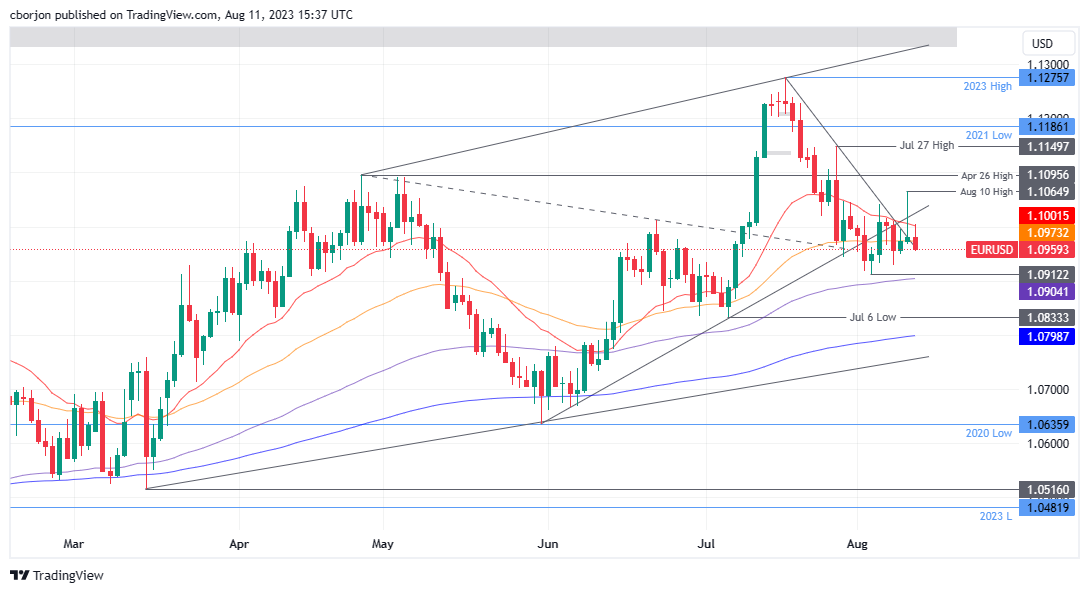EUR/USD faces downward pressures below 1.1000 after a solid US PPI report
|
- EUR/USD experienced losses during Friday’s North American session, reaching 1.0975 from a daily high of 1.1000.
- US Department of Labor report indicated Producer Price Index (PPI) growth of 0.3% MoM, exceeding expectations, with annual PPI at 0.8%. Core PPI rose by 0.3% MoM.
- University of Michigan’s survey displayed a slight drop in consumer sentiment to 71.2, while inflation outlooks for one and five years remained optimistic.
EUR/USD registered losses during Friday’s North American session after reaching a daily high of 1.1000, but an uptick in wholesale inflation in the United States (US) increased appetite for the safe-haven status of the Greenback. Hence, the EUR/USD reversed its course and trades at 1.0958, down 0.20%.
Despite touching a high of 1.1000, the Euro retreats against the strengthening US Dollar amid risk-aversion and concerns about inflation
Risk-aversion keeps flows toward the US Dollar (USD) even though consumer inflation in July cooled down, as the US Department of Labor reported on Thursday. Nevertheless, an early report but the same institution witnessed a jump in the Producer Price Index (PPI) of 0.3% MoM above estimates of 0.2%, while annually based ticked up from 0.2% to 0.8%. Core PPI readings which exclude volatile items to gather a better reading about inflation, rose by 0.3% MoM, exceeding estimates and the prior’s month -0.1% slide, while annually based, exceeded estimates but was unchanged, compared to June’s 2.4%.
Following the data, the EUR/USD plunged from around 1.1000 toward the 1.0960 region, extending its drop toward the daily lows of 1.0954 before finding bids and recovering some ground.
The University of Michigan recently revealed that consumer sentiment has deteriorated compared to July 71.6, coming at 71.2, while inflation expectations improved. Americans think inflation in the one and five years horizon would ease, from 3.4% to 3.3% and from 3% to 2.9%, respectively.
In the meantime, the US Dollar Index (DXY), a basket of six currencies vs. the Greenback, stands flat at 102.619, although higher US Treasury bond yields would suggest a stronger US Dollar. The US 10-year benchmark note sits at 4.125%, gains one basis point.
Across the pond, the Eurozone (EU) docket featured inflation data in France and Spain, which showed mixed readings, as France’s inflation was below June’s figures, while Spain’s inflation was above the prior’s month but as expected. In the meantime, a Reuters poll showed that 37 of 70 economists expect the European Central Bank (ECB) to keep rates unchanged in September. Suppose the ECB raises borrowing costs past 4%. It would be the highest deposit rate since the Euro’s introduction in 1999.
Although the interest rates differential favors the US Dollar, uncertainty in the US and the Eurozone could keep choppy trading conditions. Nevertheless, the next week’s EU docket would be busy compared to the US, and if inflation figures show an improvement, that could be bearish for the EUR.
EUR/USD Price Analysis: Technical outlook
After reaching a weekly high of 1.1065 after the release of US consumer inflation, the pair failed to regain the 1.1000 mark, opening the door for further losses. On the upside, EUR/USD price action is capped by the 20-day Exponential Moving Average (EMA) at 1.1003, followed by a two-month-old resistance turned trendline, previous support at around 1.1030/50. With the Relative Strength Index (RSI) remaining at bearish territory and price action failing to achieve a higher peak, the EUR/USD could dip lower, with support emerging at 1.0950, before falling to its month-to-date (MTD) low of 1.0912.
Information on these pages contains forward-looking statements that involve risks and uncertainties. Markets and instruments profiled on this page are for informational purposes only and should not in any way come across as a recommendation to buy or sell in these assets. You should do your own thorough research before making any investment decisions. FXStreet does not in any way guarantee that this information is free from mistakes, errors, or material misstatements. It also does not guarantee that this information is of a timely nature. Investing in Open Markets involves a great deal of risk, including the loss of all or a portion of your investment, as well as emotional distress. All risks, losses and costs associated with investing, including total loss of principal, are your responsibility. The views and opinions expressed in this article are those of the authors and do not necessarily reflect the official policy or position of FXStreet nor its advertisers.
